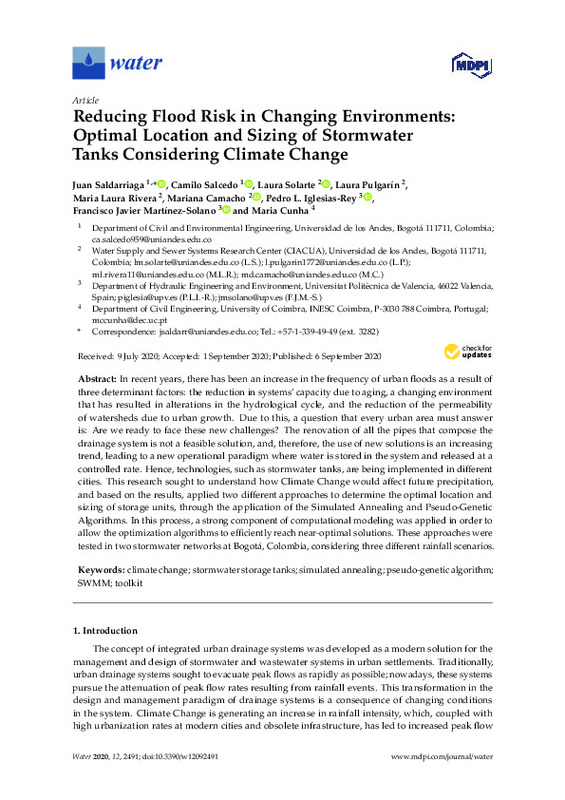Willems, P., Arnbjerg-Nielsen, K., Olsson, J., & Nguyen, V. T. V. (2012). Climate change impact assessment on urban rainfall extremes and urban drainage: Methods and shortcomings. Atmospheric Research, 103, 106-118. doi:10.1016/j.atmosres.2011.04.003
Padulano, R., Reder, A., & Rianna, G. (2019). An ensemble approach for the analysis of extreme rainfall under climate change in Naples (Italy). Hydrological Processes, 33(14), 2020-2036. doi:10.1002/hyp.13449
Zeroual, A., Assani, A. A., Meddi, M., & Alkama, R. (2018). Assessment of climate change in Algeria from 1951 to 2098 using the Köppen–Geiger climate classification scheme. Climate Dynamics, 52(1-2), 227-243. doi:10.1007/s00382-018-4128-0
[+]
Willems, P., Arnbjerg-Nielsen, K., Olsson, J., & Nguyen, V. T. V. (2012). Climate change impact assessment on urban rainfall extremes and urban drainage: Methods and shortcomings. Atmospheric Research, 103, 106-118. doi:10.1016/j.atmosres.2011.04.003
Padulano, R., Reder, A., & Rianna, G. (2019). An ensemble approach for the analysis of extreme rainfall under climate change in Naples (Italy). Hydrological Processes, 33(14), 2020-2036. doi:10.1002/hyp.13449
Zeroual, A., Assani, A. A., Meddi, M., & Alkama, R. (2018). Assessment of climate change in Algeria from 1951 to 2098 using the Köppen–Geiger climate classification scheme. Climate Dynamics, 52(1-2), 227-243. doi:10.1007/s00382-018-4128-0
Arnbjerg-Nielsen, K., Willems, P., Olsson, J., Beecham, S., Pathirana, A., Bülow Gregersen, I., … Nguyen, V.-T.-V. (2013). Impacts of climate change on rainfall extremes and urban drainage systems: a review. Water Science and Technology, 68(1), 16-28. doi:10.2166/wst.2013.251
Ashley, R. M., Balmforth, D. J., Saul, A. J., & Blanskby, J. D. (2005). Flooding in the future – predicting climate change, risks and responses in urban areas. Water Science and Technology, 52(5), 265-273. doi:10.2166/wst.2005.0142
Ngamalieu-Nengoue, U. A., Martínez-Solano, F. J., Iglesias-Rey, P. L., & Mora-Meliá, D. (2019). Multi-Objective Optimization for Urban Drainage or Sewer Networks Rehabilitation through Pipes Substitution and Storage Tanks Installation. Water, 11(5), 935. doi:10.3390/w11050935
Lee, E. H., & Kim, J. H. (2017). Design and Operation of Decentralized Reservoirs in Urban Drainage Systems. Water, 9(4), 246. doi:10.3390/w9040246
Kändler, N., Annus, I., Vassiljev, A., & Puust, R. (2019). Peak flow reduction from small catchments using smart inlets. Urban Water Journal, 17(7), 577-586. doi:10.1080/1573062x.2019.1611888
Miao, Z.-T., Han, M., & Hashemi, S. (2019). The effect of successive low-impact development rainwater systems on peak flow reduction in residential areas of Shizhuang, China. Environmental Earth Sciences, 78(2). doi:10.1007/s12665-018-8016-z
Martínez, C., Sanchez, A., Galindo, R., Mulugeta, A., Vojinovic, Z., & Galvis, A. (2018). Configuring Green Infrastructure for Urban Runoff and Pollutant Reduction Using an Optimal Number of Units. Water, 10(11), 1528. doi:10.3390/w10111528
Cunha, M. C., Zeferino, J. A., Simões, N. E., Santos, G. L., & Saldarriaga, J. G. (2017). A decision support model for the optimal siting and sizing of storage units in stormwater drainage systems. International Journal of Sustainable Development and Planning, 12(01), 122-132. doi:10.2495/sdp-v12-n1-122-132
Ngamalieu-Nengoue, U., Iglesias-Rey, P., Martínez-Solano, F., Mora-Meliá, D., & Saldarriaga Valderrama, J. (2019). Urban Drainage Network Rehabilitation Considering Storm Tank Installation and Pipe Substitution. Water, 11(3), 515. doi:10.3390/w11030515
Cimorelli, L., Morlando, F., Cozzolino, L., Covelli, C., Della Morte, R., & Pianese, D. (2016). Optimal Positioning and Sizing of Detention Tanks within Urban Drainage Networks. Journal of Irrigation and Drainage Engineering, 142(1), 04015028. doi:10.1061/(asce)ir.1943-4774.0000927
Duan, H.-F., Li, F., & Yan, H. (2016). Multi-Objective Optimal Design of Detention Tanks in the Urban Stormwater Drainage System: LID Implementation and Analysis. Water Resources Management, 30(13), 4635-4648. doi:10.1007/s11269-016-1444-1
Iglesias-Rey, P. L., Martínez-Solano, F. J., Saldarriaga, J. G., & Navarro-Planas, V. R. (2017). Pseudo-genetic Model Optimization for Rehabilitation of Urban Storm-water Drainage Networks. Procedia Engineering, 186, 617-625. doi:10.1016/j.proeng.2017.03.278
Martínez-Solano, F., Iglesias-Rey, P., Saldarriaga, J., & Vallejo, D. (2016). Creation of an SWMM Toolkit for Its Application in Urban Drainage Networks Optimization. Water, 8(6), 259. doi:10.3390/w8060259
García, L., Barreiro-Gomez, J., Escobar, E., Téllez, D., Quijano, N., & Ocampo-Martinez, C. (2015). Modeling and real-time control of urban drainage systems: A review. Advances in Water Resources, 85, 120-132. doi:10.1016/j.advwatres.2015.08.007
Stevens, B., Giorgetta, M., Esch, M., Mauritsen, T., Crueger, T., Rast, S., … Roeckner, E. (2013). Atmospheric component of the MPI‐M Earth System Model: ECHAM6. Journal of Advances in Modeling Earth Systems, 5(2), 146-172. doi:10.1002/jame.20015
Magi, B. I. (2015). Global Lightning Parameterization from CMIP5 Climate Model Output. Journal of Atmospheric and Oceanic Technology, 32(3), 434-452. doi:10.1175/jtech-d-13-00261.1
Dunne, J. P., John, J. G., Adcroft, A. J., Griffies, S. M., Hallberg, R. W., Shevliakova, E., … Zadeh, N. (2012). GFDL’s ESM2 Global Coupled Climate–Carbon Earth System Models. Part I: Physical Formulation and Baseline Simulation Characteristics. Journal of Climate, 25(19), 6646-6665. doi:10.1175/jcli-d-11-00560.1
Voldoire, A., Sanchez-Gomez, E., Salas y Mélia, D., Decharme, B., Cassou, C., Sénési, S., … Chauvin, F. (2012). The CNRM-CM5.1 global climate model: description and basic evaluation. Climate Dynamics, 40(9-10), 2091-2121. doi:10.1007/s00382-011-1259-y
Ackerley, D., & Dommenget, D. (2016). Atmosphere-only GCM (ACCESS1.0) simulations with prescribed land surface temperatures. Geoscientific Model Development, 9(6), 2077-2098. doi:10.5194/gmd-9-2077-2016
Yazdi, J., Lee, E. H., & Kim, J. H. (2015). Stochastic Multiobjective Optimization Model for Urban Drainage Network Rehabilitation. Journal of Water Resources Planning and Management, 141(8), 04014091. doi:10.1061/(asce)wr.1943-5452.0000491
Javier Martínez-Solano, F., Iglesias-Rey, P. L., Mora Meliá, D., & Ribelles-Aguilar, J. V. (2018). Combining Skeletonization, Setpoint Curves, and Heuristic Algorithms to Define District Metering Areas in the Battle of Water Networks District Metering Areas. Journal of Water Resources Planning and Management, 144(6), 04018023. doi:10.1061/(asce)wr.1943-5452.0000938
Baek, H., Ryu, J., Oh, J., & Kim, T.-H. (2015). Optimal design of multi-storage network for combined sewer overflow management using a diversity-guided, cyclic-networking particle swarm optimizer – A case study in the Gunja subcatchment area, Korea. Expert Systems with Applications, 42(20), 6966-6975. doi:10.1016/j.eswa.2015.04.049
McEnery, J. A., & Morris, C. D. (2011). Muskingum optimisation used for evaluation of regionalised stormwater detention. Journal of Flood Risk Management, 5(1), 49-61. doi:10.1111/j.1753-318x.2011.01125.x
Cunha, M. C., Zeferino, J. A., Simões, N. E., & Saldarriaga, J. G. (2016). Optimal location and sizing of storage units in a drainage system. Environmental Modelling & Software, 83, 155-166. doi:10.1016/j.envsoft.2016.05.015
Kirkpatrick, S., Gelatt, C. D., & Vecchi, M. P. (1983). Optimization by Simulated Annealing. Science, 220(4598), 671-680. doi:10.1126/science.220.4598.671
Del Giudice, G., & Padulano, R. (2016). Sensitivity Analysis and Calibration of a Rainfall-Runoff Model with the Combined Use of EPA-SWMM and Genetic Algorithm. Acta Geophysica, 64(5), 1755-1778. doi:10.1515/acgeo-2016-0062
[-]









